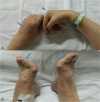Pramipexole-induced limb dystonia and its associated complex regional pain syndrome in idiopathic Parkinson's disease: A case report
- PMID: 28700507
- PMCID: PMC5515779
- DOI: 10.1097/MD.0000000000007530
Pramipexole-induced limb dystonia and its associated complex regional pain syndrome in idiopathic Parkinson's disease: A case report
Abstract
Rationale: This case may be due to basal ganglia dysfunction, which was probably caused by abnormal activation of dopamine 1-like receptor (D1R) boosted by pramipexole binding on dopamine 3-like receptor (D3R) in a situation where D3R was overexpressed by the chronic treatment of L-dopa.
Patient concerns: Striatal hand and foot deformities.
Diagnoses: Striatal hand and foot deformities with CRPS.
Interventions: Steroid treatemnt and withdrawal of the pramipexole.
Outcomes: Recovered significantly.
Lessons: Since the degree of overexpression of D3R is increased in a high dose of pramipexole, for patients with PD who are treated with L-dopa chronically, a new use of pramipexole and an increase in dose to alleviate the symptoms of PD should be implemented with caution while closely observing the occurrence of drug-induced complications such as dystonia and CRPS.
Conflict of interest statement
The authors have no conflicts of interest to disclose.
Figures


Similar articles
-
Pramipexole-associated fixed limb dystonia in Parkinson's disease.Parkinsonism Relat Disord. 2016 Oct;31:159-160. doi: 10.1016/j.parkreldis.2016.08.018. Epub 2016 Aug 26. Parkinsonism Relat Disord. 2016. PMID: 27591073 No abstract available.
-
Pramipexole for the treatment of depressive symptoms in patients with Parkinson's disease: a randomised, double-blind, placebo-controlled trial.Lancet Neurol. 2010 Jun;9(6):573-80. doi: 10.1016/S1474-4422(10)70106-X. Epub 2010 May 7. Lancet Neurol. 2010. PMID: 20452823 Clinical Trial.
-
Pramipexole extended release in Parkinson's disease.Expert Rev Neurother. 2011 Sep;11(9):1229-34. doi: 10.1586/ern.11.122. Expert Rev Neurother. 2011. PMID: 21864066 Review.
-
Pramipexole extended release: in Parkinson's disease.CNS Drugs. 2010 Apr;24(4):327-36. doi: 10.2165/11204570-000000000-00000. CNS Drugs. 2010. PMID: 20297857 Review.
-
Telogen effluvium associated with the dopamine agonist pramipexole in a 55-year-old woman with Parkinson's disease.J Am Acad Dermatol. 2006 Nov;55(5 Suppl):S103-4. doi: 10.1016/j.jaad.2005.09.039. J Am Acad Dermatol. 2006. PMID: 17052518 No abstract available.
Cited by
-
Algorithm for multimodal medication therapy in patients with complex regional pain syndrome.J Yeungnam Med Sci. 2023 Nov;40(Suppl):S125-S128. doi: 10.12701/jyms.2023.00360. Epub 2023 Jul 12. J Yeungnam Med Sci. 2023. PMID: 37434359 Free PMC article.
-
Effectiveness of Intravenous Immunoglobulin for Management of Neuropathic Pain: A Narrative Review.J Pain Res. 2020 Nov 12;13:2879-2884. doi: 10.2147/JPR.S273475. eCollection 2020. J Pain Res. 2020. PMID: 33209055 Free PMC article. Review.
-
Usefulness of F-18 FP-CIT PET to predict dopamine-responsive hand tremor in patients other than Parkinson's disease: Two case reports.Medicine (Baltimore). 2018 Jun;97(22):e10983. doi: 10.1097/MD.0000000000010983. Medicine (Baltimore). 2018. PMID: 29851853 Free PMC article.
-
Recurrent complex regional pain syndrome type I in a patient with amyotrophic lateral sclerosis: a case report.Neurol Sci. 2018 Aug;39(8):1487-1488. doi: 10.1007/s10072-018-3305-6. Epub 2018 Mar 9. Neurol Sci. 2018. PMID: 29524044 No abstract available.
-
Anti-allodynic effect of interleukin 10 in a mouse model of complex regional pain syndrome through reduction of NK1 receptor expression of microglia in the spinal cord.J Pain Res. 2018 Sep 4;11:1729-1741. doi: 10.2147/JPR.S166624. eCollection 2018. J Pain Res. 2018. PMID: 30233230 Free PMC article.
References
-
- Ashour R, Tintner R, Jankovic J. Striatal deformities of the hand and foot in Parkinson's disease. Lancet Neurol 2005;4:423–31. - PubMed
-
- Doherty KM, van de Warrenburg BP, Peralta MC, et al. Postural deformities in Parkinson's disease. Lancet Neurol 2011;10:538–49. - PubMed
-
- Pandey S, Jain S. Pramipexole-associated fixed limb dystonia in Parkinson's disease. Parkinsonism Relat Disord 2016;31:159–60. - PubMed
-
- Suzuki M, Hirai T, Ito Y, et al. Pramipexole-induced antecollis in Parkinson's disease. J Neurol Sci 2008;264:195–7. - PubMed
Publication types
MeSH terms
Substances
LinkOut - more resources
Full Text Sources
Other Literature Sources
Medical

